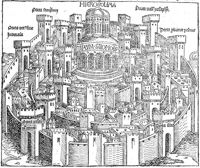When President Barack Obama laid out his vision for moving forward on the Israeli-Palestinian peace process last week, he -- like the Clinton and Bush administrations before him -- emphasized trying to settle the question of borders first, while deferring negotiations on more contentious issues, like the status of Jerusalem, for later. Indeed, at first glance, the question of Jerusalem appears to be insolvable, given both sides' starting points for negotiation. Speaking before the U.S. Congress this week, Israeli Prime Minister Benyamin Netanyahu declared, "Jerusalem must never again be divided. Jerusalem must remain the united capital of Israel. I know this is a difficult issue for Palestinians. But I believe that, with creativity and with good will, a solution can be found."
The problem is that we have not seen much creativity in the negotiations between Israelis and Palestinians. Netanyahu's stance suggests that both a partition of Jerusalem and a return to the 1947 proposal to "internationalize" the city are nonstarters. With no roadmap to reconcile competing and apparently irreconcilable claims to the same piece of real estate, it is hardly surprising that negotiators prefer to work on questions where there might be the possibility of reaching some sort of conclusive settlement.
This strategy, which has guided the peace process in fits and starts for the past two decades, has not borne fruit. And so it might be time for a change of course. Breaking the logjam on Jerusalem by laying out a feasible, workable blueprint for how competing Israeli and Palestinian claims can be accommodated might be the catalyst to get the other pieces of the peace process jigsaw puzzle to fall into place.

